#there's nothing like the resonant beats of dissonant chords
Explore tagged Tumblr posts
Text
ough,,, I miss choir
#there's nothing like being a part of beautiful harmony#there's nothing like fading together into blissful silence#there's nothing like the satisfaction of a resolving chord#there's nothing like being the support that allows sopranos to rise#there's nothing like the resonant beats of dissonant chords#fuck I miss choir#cray kay scream
10 notes
·
View notes
Text
Degrees of Freedom
[AO3] [Dreamwidth]
-
Marty thought, in the brief flash of light that warped his view of the Twin Pines Mall parking lot and his memory of Doc lying behind him, prone and silent and still, that he could almost hear the melody of the universe. See also: Holonomic constraints
-
He lived for music. Picking at his guitar, amp reverberating what pulsed through his veins down his fingertips, accompanied by nothing or anything, he felt connected to the world in a way that school or Jennifer had trouble reaching.
It was a testament to how many hours he had spent at Doc’s garage, jamming out mindlessly to the tune of clanging construction and letting his voice be carried along what the strings spoke to him, that even now, frantic and grieving, he instinctively puzzled over the sparking cues of the DeLorean as he sped toward eighty-eight miles an hour.
Marty thought, in the brief flash of light that warped his view of the Twin Pines Mall parking lot and his memory of Doc lying behind him, prone and silent and still, that he could almost hear the melody of the universe.
Later, when he had hopped time the way his fingers hopped the fret board and with equal urgency pumping his heart faster, he listened to Doc’s monologue of how the universe self-corrected. It made sense to him, now, and he blurted out, “Like a dissonant chord.”
Doc blinked at him, a similitudinous echo of the expression the Doc of ’55 had given him when he tried to explain that time-travel was not only possible, but probable. His brows scrunched together, and he watched his friend throw his magnificent mind at the problem.
Maybe it was a side-effect of time travel, but he bounced in place, fingers tapping out a rhythm he couldn’t remember if he tried, only knew it by sense-memory, as he waited for whatever output Doc’s brain would come up with from this new input. It was new, knew it as strongly as he knew his bone-deep senses, but at the same time it felt like it had been there – guiding him – all along.
“Yes,” Doc murmured, looking at him thoughtfully, “I suppose that’s exactly it.”
He got a taste of his own theory in 2015, how bitterly the future – either of them – sat on his tongue, his hand twitching to a rhythm persistently unlike the one his dour, bitter future self was imprinted with. Even 1985B resonated badly to him, like a set of strings tightened to their extremes and too frightful to play without risking a scarring injury.
Pocket burning with the image of a changing tombstone, Marty felt he could almost hear it now, a thumping underneath his pulse that worked in time with his instinctive calls to action. Clara rang… not wrong, but missing – as if the thundering clops of hoof-beats were a counterpoint that could lead anywhere, even to a ravine.
It made him feel a little bit scraped raw, a shell of circumstance that pushed him to rattle forth into Doc’s place. He girded himself against the clanging notes sleuthing through his subconscious, too ready to throw his own handful of earth upon the grave of cacophony he and Doc had created.
The feeling stuck with him, past the sublime echo of an improvised bullet-proof vest and the DeLorean being smashed to pieces on the train tracks he had scrambled away from. Jennifer felt about as real as Clara – circumstances, notes, rather, that worked with the song he could now feel, but never as perfect of a match as they could be.
He caught his breath, in this unmoored 1985 that was neither A, nor B, nor C, and let his fingers dance to the tune time had introduced him to.
-
Author's Notes
Degrees of Freedom (often abbreviated df or DOF) refers to the number of independent variables or parameters of a system. In various scientific fields, the word "freedom" is used to describe the limits to which physical movement or other physical processes are possible. This relates to the philosophical concept to the extent that people may be considered to have as much freedom as they are physically able to exercise.[citation needed]
- Wikipedia
In classical mechanics, holonomic constraints are relations between the position variables (and possibly time[1]) that can be expressed in the following form: f(u1, u2, u3, … un, t) = 0 where {u1, u2, u3, … un} are the n generalized coordinates that describe the system. For example, the motion of a particle constrained to lie on the surface of a sphere is subject to a holonomic constraint, but if the particle is able to fall off the sphere under the influence of gravity, the constraint becomes non-holonomic.
- Wikipedia
I was originally going to remix a title from the Dying Earth (genre) wiki, but the urge to toss in some physics reference was a bit too strong to ignore. I worked backwards this time (ha) in comparison to my Quantum Leap fic Restoring Force when it came to summary references, but degrees of freedom and holonomic constraints are indeed directly related to each other, via the term "configuration space", which may or may not be computed with time as a variable as one wishes.
Music accompaniment: "Distorted Light Beam" by Bastille (lyrics here)
4 notes
·
View notes
Note
1920s, Crowley in a flapper dress
She’d found Aziraphale sitting at the bar; leaned into his shoulders from behind - well, fell into his shoulders, really - the sound of her Mary Janes skittering across the polished parquet floor echoed the tap tap tap of the cymbals on stage, resonant even amidst the clamour of the band’s horn section.
“Angel!” And she was drunk, drunker than Aziraphale had ever seen her, possibly drunker than anyone’s ever been and survived. What did the locals call it? Smoked. Zozzled. Ossified. Out on the roof. She was drunk enough that Aziraphale was more shocked by that, by her graceless stumble and flushed cheeks, than actually seeing her again after decades of one-sided, desperate attempts at communication.
I visited. You weren’t there. You haven’t been home in years.
She was laughing, whether at the very sight of him here of all places or just because of the alcohol poisoning her blood, Aziraphale wasn’t sure. It was uninhibited and musical, a cheerful allegro like the jazz of the club, and she straightened up only to fall into him again, laughing more, face pressed into the back of his neck. “It’sss good to sssee you, angel.” Aziraphale shivered; he could feel her breath, smell the acrid alcohol on it, and he pivoted off his stool before she could fall again, and took her by her bare arm. Such a recent trend, these bare arms, and despite living lifetimes upon lifetimes before modesty had even been imagined, the speakeasy seemed to dim around him at the feel of Crowley’s naked arm - the bony length of it peppered with tan freckles so delicate Aziraphale thought that if he were to blow across her skin, they may get caught in the air and drift away like dandelion seeds; the soft curve of her forearm tapering to a delicate wrist; an elbow that begged to be held, guided, offered support - it would have been so scandalous a thing only a few decades ago, this exposed skin. Bolts of fabric separated them at their last meeting.
“New York suits you,” he’d told her as he helped her onto the stool next to his, lifted her up at the hips as though she weighed nothing. She was more chiffon and beads and pearls than body, the sort of slight figure the decade craved, a Fitgeraldian muse made real. She leaned into his touch, and Aziraphale would have said something else, God only knows what, had she not swayed so.
The speakeasy was a shrine to dangerous pleasures. It’s as if it was made for you. Perhaps it was made by you. A church, no, a cathedral; a place of congregation and worship, of communion. Communicants partook in the Eucharist with poorly distilled spirits that reeked of carbonic acid; the altar was laid with dirty glasses and ashtrays. Did Crowley inlay the mosaics of this basilica with jazz music, press sharp notes into its walls and ordain them with hymns from a tenor saxophone?
It was a place that venerated the prohibited: the drinking, the gambling, the dancing, the skirts and their hems creeping higher with every passing year, and the men who pushed them higher still in intimate moments on the dance floor, men who slipped drunken hands between nyloned legs and women who let them with airy laughs.
That dress suits you, he thought: the fall of it over her thighs, the way the tassels spread out over nyloned knees leaving glimpses of skin through sheer fabric, and Aziraphale made a point not to think of her bent over a bed some hours prior, pulling the silk stockings over smooth calves and up her thighs, hooking them into tightly cinched garters. The embroidered beads were stitched in geometric Art Deco patterns across her bust. Architectural. The Chrysler Building they’re engineering on Lexington Avenue, a modern Cattedrale di Santa Maria del Fiore, a wonder.
He grasped her by the elbow and remained standing next to her. “Going to catch me if I fall?” Her words were slurred, her eyes alight even behind shaded glasses.
Syncopation. That’s what made jazz jazz, or so Crowley would later claim over drinks on another night, in another decade entirely, in a different city. It was the unexpected parts of the rhythm, the off-beats and backbeats, oddly accented notes and chords, disturbances in the flow of the tempo, the surprise mid-song when the audience anticipated the direction - verse, chorus, bridge, as it almost always went - but the music veered wildly askew, and the ending was nowhere near where the beginning projected.
Aziraphale didn’t hear the off-beats but he finished his gin. The Body of Christ. Amen.
Crowley was still swaying, possibly to the music. She smiled at Aziraphale’s concern with a sort of condescending fondness that made Aziraphale hold her elbow tighter, and she signaled the bartender, who must have known her because in short seconds a whiskey, neat, was delivered.
It smelled foul. It wasn’t properly distilled, maybe wasn’t even actual whiskey - industrial grade alcohol - but Crowley downed it in one go and then idly smoothed the points of her bob, attention back to the stage.
“Bad day at the office? I’ve never seen you so - ”
But she wasn’t listening. “The band’sss good tonight.” Her snake was showing. Well past her wordy phase then, past a bottle or four in the backroom. Past reminiscing about eras forgotten to recorded history, past animated declarations and debates on subjects no one on Earth but the two of them recalled. She was quiet drunk now, calm drunk. Listen to music and fall asleep on Aziraphale’s settee drunk.
“You’re aware drinking is still legal in London? It’s not made in bathtubs there. Trifle better quality, I’d - ”
Crowley was still smiling warmly, and she placed a finger against Aziraphale’s lips to hush him, leaned close so that her lips grazed his ear, “It’sss good to sssee you, but don’t drown out the music, angel. This one has ssswing.” And Aziraphale was rendered silent, not for the music, which he supposed wasn’t as intolerable as he’d first thought, but because her pulse seemed to beat in time with the song’s tempo, and it reverberated up her arm and into the tips of Azirapbale’s fingers still on her elbow. They listened together, Crowley to the band and Aziraphale to the rhythm of Crowley’s body.
The song ended and an equally bombastic one began, and the dancers behind them rallied for another. “Not as good,” she said, almost catching Aziraphale’s eyes as her glasses slipped down her nose. “Been a long, a long, long - ” she stumbled for the word.
“Time?” Aziraphale offered, then nodded. “Yes, rather.” The decades had lurched by, fussy ruffles shortening to sleeveless dresses that fit her so elegantly. When did you start dressing this way? How much have I missed?
Crowley seemed unfazed and she signaled for another drink. “Why New York?”
“Business. Seeing a Mrs. Rockefeller about opening up a gallery of sorts. Promising work. Thought I’d have an evening out, see what all the fuss is about.” The bartender passed her another whiskey. “And what brings you here?”
“I like it here.” She swallowed her drink.
“New York or the Cotton Club?”
A hum, then, “Both.”
“Have you been here long?”
“I just hopped over to unwind after the war.”
“The war ended ten years ago.”
“Needed to unwind a lot, I guess.” She reached across to him and loosened Aziraphale’s bow tie just a smidge, eyebrow cocked in a challenge, quirked lips dripping a ruby-lipsticked smile. “You ssshould unwind a little.”
Aziraphale dismissed the gesture. “Listen, I’m dreadfully sorry about that business in St James’s - ”
“Nah, nah, none of that.” She waved her arm and toppled into him.
“It’s just that it’s been so long and I never intended to upset - ” He’d practiced the words on the steps of Crowley’s flat, whispered them to a closed door.
“Ssstop it, it’sss done.” She was still leaning on him, close enough that Aziraphale could see under her glasses to eyes heavy with charcoal and the weight of millennia.
Aziraphale wanted to finish - This isn’t fraternizing. This matters, whatever it is that this even is, but Crowley wasn’t receptive, and he wouldn’t drag her through it when she was hardly able to sit up without falling. It was enough to be in her company again. “Are you planning on staying much longer? I’m sure there’s plenty of tempting to be done in New York.” And Crowley laughed again, a little hysterical this time, as Aziraphale helped her sit back up on the stool.
“Nah, wouldn’t work. Can’t leave London for good.”
“And why’s that, my dear?”
It was as if his words absorbed the alcohol and she was suddenly cool-headed, straight-backed, words exacting, cutting. “You’re in London,” she said on the off-beat, and Aziraphale reeled from the tempo change, from the dissonant chords. A bent note played by sliding between the established ones, a jolt away from the assumed.
She started as if to signal the bartender again, but Aziraphale slipped his hand around her wrist.
“Time to sober up, I’d wager. Can’t be good for you, all this counterfeit alcohol.”
“Don’t want to hear the truth?” She was still slurring, but her face was hard and composed.
“Best to stop before you say something you’ll regret.”
“I’ll regret saying it or you’ll regret hearing it?” She’d removed her glasses in public for the first time Aziraphale could recall in centuries, and her Kohl-rimmed eyes were bloodshot.
“Both, I imagine.”
She flung herself off the stool and into the crowd, glasses back on, wobbling only a few steps in her heels before Aziraphale caught her by the arm.
“If you’re unwilling to sober up, at least let me help you home. Where are you staying?”
She pulled into him, took his hand like they were dancing, like they were the sort of people who danced together often enough they were good at it, tuned to the other’s movements and rhythm, and she said to him, “You’ll put me to bed?” Her voice was thick with whiskey and mourning. “Isss that all you want, angel?”
He could picture it, there on the dance floor holding her hand like they might be lovers, like this might be an unremarkable evening out like any other. He could envision coming home to a shared flat, unlocking the door and flipping on a familiar light switch in a hall decorated with both their things. He’d remove her coat, glide it off her shoulders and down now bare arms, and the fur lining would caress her naked skin. She would lean against him as he hung her coat in a closet, and whisper to him, “Put me to bed?” Too drunk to do little more than be scooped up and carried to their bed, where he’d cushion her against velvet pillows so she would be comfortable, her short hair fanned out around her like a halo, and he’d hike up her slip and dress - God, she was so beautiful in that dress, all right angles and hard corners longing to be softened, a dress he could have bought her in this little fantasy, purchased it at some unseemly shop that reputable people would never visit, and he would have left it on their bed in a gift box for her to find and unwrap some afternoon - it would have been the first time she wore it out, and it would be a shame to take it off now when it clung to her like a second skin. So he’d shimmy the beaded fringe past her garters, and over jagged hip bones, sharp like a note, like a semitone step up on a work of sheet music. “Bed me, angel?” She’d ask as he lifted her hips up to drag her knickers down, and she’d make the sweetest sound when he’d dip his tongue into her, musical like her laugh, an elegy for lost and wasted time, an open cadence, an unfinished song, uncomposed and wanting.
Aziraphale said nothing but still held Crowley’s hand. The final notes hummed through the club and someone announced the next performers to a temporary lull in the music. Crowley pulled back and gestured wildly at the stage. “Don’t like jazz, do you? It’s because of the polyphony - you know what that even isss, angel? Ever study any mus-music-musical theory at the opera? It’sss when competing melodiesss overlap. When the Goddamn bass playsss opp-oppos - ” She slurred, shaking her head in frustration, “When the bass or sssaxophone or piano or what-the-fuck-ever playsss counterpoint to the trumpet or some other instrument, and it ssshould be a fucking messss, and it is if you’re listening to the individual melodies only, but if you can get past the fucking dissonance of it, you’d sssee it’s fucking harmonious and it all fits together.” She took a step back. “You can’t listen for ssshit, angel.”
“Crowley - ”
“I’ll come back to London when I ssstop hearing the harmony.”
The band picked back up and Crowley left.
#good omens#Ineffable Husbands#my fic#ficlet#prompt response#good omens ficlet#because the St James's fight wasn't enough for me I guess
160 notes
·
View notes
Text
Buzzsaw on Quaaludes: Killing Joke and the Guitar Stylings of Geordie Walker
Killing Joke has had a sole guitarist since its formation in 1979; a man who never receives the credit he deserves, save from the countless musicians he has inspired and his fans. He is a guitarist's guitarist – a player whose genius you cannot fully appreciate, unless you yourself share his craft. His name is Kevin Walker; but is known to most as ‘Geordie’.

Geordie Walker performing in Finland, 2009. (Photo by Thomas Vitikainen)
There aren't very many guitarists, whom you can recognize on a track solely based on style of play. Geordie Walker is certainly one of them.
Wikipedia describes his "unorthodox style of play" as "Byrds-like chiming arpeggios of repetitive and somewhat somber melodies with a hypnotic long-sustain tone". It is one reason why his play is so instantly recognizable and fascinating, but it is not the whole story.
While experimental in his ethos – and possessing a first wave post-punk background similar to Daniel Ash, Bernard Sumner, or Billy Duffy – Geordie Walker is a different species from these three. He bookends the fiddly, reverberating, scratchy, ingenuity of post-punk instrumentation, with some of the most inventive and memorable heavy riffage in rock history.
This is something which the mainstream has completely failed to bestow due credit for, in spite of concurrently acknowledging his "influence" the scant few times it has deemed him worthy of mention. This is an injustice which Killing Joke as a collective musical unit has long struggled with – the namedropping of stars who have owned their records, taking precedence over their actual music.
Early Output
London-based Killing Joke started out as a wonky dub outfit, releasing their first EP, Turn to Red, in 1979.
While perfectly adequate, within the narrow confines of the style of music his band was then playing; Walker's work on this release was not overly remarkable. It was within the following year, as the band began to take a more aggressive sonic approach – in response to the energetic environment of live shows – that he began to break the mould.
The 1980 single ‘Wardance’; accompanied by the equally famous b-side Pssyche; is a deliciously primitive release. ‘Wardance’ is what would happen if a Neu! cover band, or some other krautrock outfit, performed in "The Upside Down" from Stranger Things. A savage caveman beat by drummer Paul Ferguson introduces a fuzz-laden funk bassline. Then, Geordie does something quite interesting:
His riff on this song is one chord; played with the "scat" rhythm which has long been an aural trademark of reggae, dub, and ska. There was nothing remarkable about this in 1980 – The Clash, as well as other British punk and post-punk acts had been there, and done that. But this particular instance of it, was played with heavy distortion on the open E string – the lowest possible chord in E standard tuning. In other words, this was less of a "scat" and more of a "thwomp".
This minor change to a rather stale trope, was simply a stroke of genius. Killing Joke has downtuned their instruments since the early 80s; and as this video of them performing the song here in the teens shows, it has made the song even more utterly monstrous as it has aged.
On these earlier releases, Geordie Walker had not yet built up his distinctive style to its classic form. The Turn to Red EP, ‘Wardance’ single, self-titled Killing Joke debut album of 1980; and follow-up, what's THIS for...! (1981); were all recorded in E standard tuning, rather than the lower D standard tuning, which has now been used by Killing Joke for about thirty-five years.
More importantly, on all of those releases; plus 1982's Revelations; Geordie is without his most recognizable trademark: his yellow-gold, hollow-bodied Gibson ES-295 guitar. He had not purchased it yet at this time, and instead used a Gibson SG.
[Edit: I've also seen a video of a television performance from this period where he has a Fender Stratocaster, but the band is miming along to a studio recording, and I see no evidence that he ever used it in the studio or during any real live performances.]
Walker's nascent sound on these first four releases was thin and wiry; it is high-pitched, sharp, and has very clear definition, in contrast to his later multilayered textures, blanketing eerie harmonics. But it still has its charm, and the work he does with it is still very recognizably Geordie. But this was Geordie Walker 1.0: a sound that he would leave in the early 80s, and never again return to.
Recently, Jaz Coleman joined the Foo Fighters onstage in Prague to perform ‘Requiem’ off of Killing Joke’s first album. Although the performance is dreadful aside from Jaz Coleman's vocals, I noticed two things: first, three guitarists combined, sounding far less impressive than Walker does on his own; but also, that this may have been the first time that Requiem had been performed in its original tuning by a member of Killing Joke since 1982.
Killing Joke (1980) was the band's debut album, featuring many songs which would later become staples in Killing Joke's live setlist. It begins with the aforementioned track Requiem; a slow, thumping, buzzing, clockwork eulogy for humanity after an apocalypse.
When performed live, to lessen the monotony of repeating the riff throughout the whole song, Geordie will often do some improvisation following the first chorus; slide up from the second fret to the fourteenth to play it during the second and third choruses; or switch from the neck pickup to the bridge pickup during the second and third verses, to back up Jaz Coleman's vocals with a more muddy, chiming tone. All of these live quirks can be seen exhibited during this performance of the song.
Also of interest on the debut album, are ‘The Wait’, a white-hot early industrial metal masterpiece, which contains what may be the grandest riff of Geordie Walker's career. S.O.36 is a rarely-performed, extremely underrated cut, for which he provides dissonant, ghostly arpeggios. I also find the riff of Primitive fascinating; because, (to me, at least) it bears some resemblance to Ron Asheton's riff on The Stooges' ‘T.V. Eye’. Walker is such an underivative guitarist, that it's intriguing when he actually gives glimpses of who his influences may be.
Walker's sound began to evolve on 1982's Revelations. I personally consider it to be a quite mediocre album, but Geordie has his moments on it. The guitar on tracks such as ‘The Hum’, and ‘The Pandys are Coming’ is bone-chilling. This album was supposedly the first on which Killing Joke downtuned their instruments – but only a half step down, instead of the full step D standard tuning which would first appear on 1983's ‘Fire Dances’.
Geordie's tone on the album is far different from the two that preceded it. The distorted, wiry, scratchy, sound of those early releases, was replaced with an airy, clean chime, with a boost to the mid-range frequencies. The result is guitar parts which have a clattering, messy smack to them – instead of a razor edged high-end hiss.
Fire Dances
The sound Walker introduced on Revelations was taken to a logical conclusion the following year, on Fire Dances (1983). The most significant development of his guitar work on this album, was the debut of his signature hollow-bodied 1952 Gibson ES-295. It was a milestone, as swapping out a solid body for a hollow one gave his sound far more resonance and presence.
"I kind of noticed that if you're using a really distorted sound, if you play complex chords, because of the harmonics in the distortion the chord will fucking disappear. I thought... if I got a semi-acoustic I could put like, a contact pickup in it and mix the acoustic sound with electric sound... and I got an old Gibson fucking catalog and I spotted it."
-- Geordie Walker in 2011 (source)
Originally released for use in big band jazz; and other forms of pre-rock 'n' roll music; in 1952, it gained notoriety as Scotty Moore's instrument of choice on Elvis's early singles. Its gold paint-job was considered outrageous at its time of release.
"To me, a hollowbody is the sound of wood making music. A solidbody is the sound of an amp."
-- Scotty Moore, 2015
Of course, in the world of distorted hard rock, and heavy metal, seeing such guitars onstage is rather a rare occurrence. It wasn't at all unheard of in the post-punk and new wave scenes (Billy Duffy comes to mind), but those players don't implement the heavy chugging, nor display other such metal influences, like Geordie does.
The first time I ever saw a video of Killing Joke performing live, I was a bit amused seeing what appeared to be an old fuddy-duddy rockabilly guitar, being used to play songs like ‘Asteroid’ or ‘Total Invasion’. I believed that the man laying down these tracks must have been a long-maned, bearded, metalhead in a t-shirt; and that the robust sound I was hearing must have been an illusion created by studio multi-tracking. I doubt that when anybody hears post-nineties Killing Joke for the first time they imagine an aloof, well-dressed gentleman nonchalantly strumming away at an Elvis guitar whilst puffing on a cigarette.
Fire Dances is Killing Joke gone psychedelic, featuring upbeat songs with vocals that alternate between childishly whimsical, and completely frantic. Geordie contributes off-kilter, dizzying melodies with a playful mood to them.
It sounds as though his bridge pickup began to see frequent use on this release, a development that would greatly expand his versatility both in-studio and onstage later in his career. A switch of pickups can be detected by the replacement of his high-end chainsaw neck pickup tone with a wet, bell-like chime. Nowadays, on many songs he will switch to his bridge pickup during verses (see: ‘Requiem’, ‘S.O.36′, ‘Primitive’, ‘Pandemonium’, ‘The Great Cull’); and on some songs he will do the opposite (see: ‘Love Like Blood’, ‘Autonomous Zone’, ‘Majestic’, ‘Hosannas’, ‘This Tribal Antidote’).
The New Wave Years
Geordie Walker's liberal usage of delay effects on Fire Dances became a staple of his sound in the commercially successful years which followed.
On 1984's Night Time, it can be argued that his sound finally progressed to vaguely what we hear today. Palm-muting and distortion made their return to his repertoire; however, instead of the icy “Geordie Walker 1.0″ sound of the first two albums, his tone maintained a resonance, density, and an imperial dignity of sorts, from Revelations and Fire Dances.
The exact combination of effects used by Walker from Night Time onward are oft-mistaken by those trying to imitate his sound. Chief among these misconceptions is that he uses a chorus pedal.
I have seen many people ask how to get their setup to sound reminiscent of Geordie Walker's on forums, and the other users will more often than not recommend chorus or stereo chorus effects. After spending countless hours fiddling around with my own guitar setup; and watching videos of Killing Joke performances, and interviews with Geordie (a very rare thing to come across); I strongly believe that he does not use – and probably hasn't ever used – chorus effects.
Delay Pedals
Instead, the resonance of his sound comes from (aside from his hollowbody guitar) clever usage of delay pedals. The users of EquipBoard, have compiled a list of some models he is seen using in various videos and photographs. They include:
The Line 6 DL4 Stompbox Delay Modeler. Spotted in a video from 2006 during the “Hosannas from the Basements of Hell” sessions.
The Electro-Harmonix Deluxe Memory Man (era not known).
The delay pedals are set up in a way which mimics chorus, but excludes some of the more "wet" elements of it. To hear the difference, listen to Killing Joke’s ‘Eighties’, followed by Nirvana's cheeky recycling of its riff in ‘Come As You Are’. On the latter, Kurt Cobain is using chorus, and the difference is quite apparent.
I also suspect that he uses a tiny amount of a phaser effect, to give his sound more ‘shimmer’; but I have no evidence to support this as of yet.
Automatic Double Trackers
Geordie also uses automatic double trackers (ADTs) to replicate the layered guitar sound on records – usually only attainable in the studio. He claims to use two at once, which is undoubtedly a paramount component in the constitution of his gargantuan sound.
The ADTs he uses are "Parmee Acoustics and Collins Electromagnetics (PA:CE) Automatic Double Trackers".
Unfortunately, it appears that the company which manufactured these is long-defunct, and as such this unit is no longer in production (as of December 2018, Ebay appears to not have a single one listed). It is described by Fletcher Stewart at Tone Report to be "perhaps one of the most elusive effect units ever made". Stewart, who was able to cop one of the devices off of the internet somehow, described its key features as "the thickest liquid stereo chorus imaginable, chewy true pitch vibrato, sine wave flanging, detuned slap back and more".
The settings on the PA:CE ADT unit Geordie makes use of, are the slapback and detuning features; which are applied sparingly.
While this specific unit may be nearly impossible to locate nowadays, an automatic double tracking effect can be created by nearly any modern delay pedal which boasts multiple outputs and a modulation feature. Modern ADT units are also available for purchase, but I cannot vouch for their aural similarity to Walker's.
Amplifiers and Heads
In the eighties, Geordie used Burman cabinets. Burman is a defunct brand, and I can find no record of it existing after that decade. As such, they may also be difficult to get your hands on.
At some point following that decade, Walker switched to a Marshall EL34 100/100 Power Amp, used with a Marshall JMP-1 Tube MIDI Preamp. Since then, he has alternated between various Marshall heads, and Framus Dragon Heads. Similarly, he has also used both Marshall and Framus speakers in conjunction with different combinations of those heads. During the Killing Joke 40th anniversary tour of 2018, he can also be seen using speakers made by Blackstar; a UK-based manufacturer founded in 2004.
The Nineties
Walker's guitar work appeared on four albums in the nineties: Killing Joke's ‘Extremities, Dirt, and Various Repressed Emotions’ (1990), ‘Pandemonium’ (1994), and ‘Democracy’ (1996); and industrial super-group Murder, Inc.'s eponymous 1992 album.
Geordie became conspicuously more influenced by hard rock and heavy metal during this period, readopting a heavily overdriven sound for the first time since 1981 for the proto-grunge Extremities, as well as Murder, Inc.; and later introducing Ministry-esque crunchy, repetitive palm-muted power chord riffs on Pandemonium. This was a turning point, as the remnants of Geordie’s new wave past were nearly completely cast into the rear-view mirror.
The musical climate of the late eighties and early nineties essentially saw the end of new wave and synthpop, as bands for whom Killing Joke's early output had been a key influence began to break into the mainstream. This, combined with the abysmal reception to Outside the Gate – an oft-forgotten and widely-panned 1988 album which Geordie’s guitar is barely even audible on – spurred the band to go loud again.
Walker experimented a lot during this period, pulling many new tricks out of his bag which would not, ultimately, carry on into the next decade and beyond. The song ‘Whiteout’ off of Pandemonium is the only Killing Joke song to feature liberal use of a wah pedal. Live performances of ‘Exorcism’, ‘Millennium’, and on occasion, ‘Whiteout’, would see Walker briefly swap his beloved ES-295 for a sunburst Gibson Les Paul Standard outfitted with white single coil pickups. This guitar was only used for these specific songs during tours in 1994 to 1996, and has not been used onstage by Geordie since.
The reason why Geordie Walker decided to bring a guitar which wasn't an ES-295 on tour with him for the first time since the early eighties is not known to me. Occam's Razor suggests he thought that the fat palm-muted tone (on the studio versions of the aforementioned tracks) would be best suited by a solid body guitar; rather than the more airy and resonant hollow body. I've never seen it discussed in any interview of his, nor did the Les Paul ever return when those songs were played on later tours. Regardless, for a brief period, it seemed Geordie didn't believe his ES-295 to be capable of providing the sound necessary for the band's heavier cuts.
It should also be noted that 1996's Democracy featured acoustic guitar overdubs on many of its tracks. Outside the Gate had also seen some sparse usage of an acoustic; but on Democracy, it is often front-and-center, especially on the title track. This was to be the last time acoustic guitar would appear on a Killing Joke album, but in a 2011 interview Walker didn't rule out the possibility of it returning for a future release.
2003 and Beyond
Killing Joke's heaviest album to date, I believe, was their 2003 self-titled release; produced by Gang of Four's Andy Gill, and featuring Dave Grohl as a guest musician on drums. Interestingly, Geordie was reportedly unhappy with how this album was mixed; which is understandable, considering the heavily-compressed loudness war production on the album, which was common in the early naughts.
His sound on the album is a beefed-up update to that which was used on the band's first self-titled album in 1980. It is ferocious, bordering on inhuman. It dominates the album, rendering the bass almost inaudible on most tracks.
‘The Death and Resurrection Show’'s palm-muted two-note riff is primitive and utterly brutal. ‘Asteroid’ sees Walker adopt drop C tuning for the first time, and the song has become Killing Joke's signature thrasher – a setlist staple which has appeared in almost every tour since 2003. Another notable Geordie moment, is ‘Blood On Your Hands’, which has an unusual, dissonant riff that sounds like a groove one would hear on an electronic track.
The 2003 release served as a template for successive new entries in the band's discography. Geordie’s style was perfected at the beginning of the new millennium, and has not seen much change since.
On 2006's Hosannas from the Basements of Hell (my personal favourite Killing Joke album), his sound is heard at its rawest. The high end on the guitar, on this album, could peel paint off walls. Listening to it makes me feel like I'm being devoured by a great machine, or being dragged on scorching hot asphalt. I've seen mutterings on the internet, that the guitar on the album's closer, ‘Gratitude’, is Geordie using a violin bow on his ES-295; but besides his expressed admiration for 60's mod rock outfit The Creation's use of the trick, I can't substantiate this.
While Geordie Walker has shown less interest in evolving his sound since 2003 than he did beforehand; the quality of his playing has been very consistent. Killing Joke's post-reunion renaissance has yielded some of their greatest songs, and Walker's outstanding riffs have been absolutely crucial to their success.
Now entering his sixties, it's a great disservice to music that he is never given his due. But most seem content with dusty old blues rockers, "iconic" hard rock axemen who are frozen in the year 1989, and the same ProTools-molded landfill bilge regurgitated ad nauseum. Geordie Walker, despite his middle age, continues to breathe life into what has become a monotonous contemporary rock & roll listening soundscape; and I hope to god that there will one day be far more unorthodox sounds out there, such as the one he has spent decades meticulously crafting.
Videos
2009 Instrumental Demos
Documentary Excerpt featuring Geordie Walker and the ES-295
Interview with Geordie Walker (2011)
Playlist of Ten Geordie Walker Instrumental Demos (2007)
#Geordie Walker#Killing Joke#Guitarists#Murder Inc.#Gibson ES-295#Gibson#Post-Punk#Burman#Framus#ES-295
4 notes
·
View notes
Text
The Bizarre Soundtrack of Jojo Part 2
Part 2: BATTLE TENDENCY
Part 2 has a very different protagonist, Joseph Joestar, who acts goofy and silly but is actually very crafty and a sly, planning two steps ahead of opponents and habitually predicting their next lines. He is very confident and charismatic but short tempered and far from the extreme gentleman that Johnathan is, although like Johnathan he has a heart of gold. In his very first scene, he defends a young black thief who stole his wallet from the brutality of two corrupt cops.
The part is set in the 1930s but the music very intentionally avoids reflecting this. It has a lot more electronic music fitted to the exaggerated swagger and wily nature of Joseph.
In this part, the scoring continues to embrace soundscape-based elements such as the eerie whispering in the cue Deep Curse song:
https://www.youtube.com/watch?v=bhMePcvV-KQ
This first plays when Speedwagon makes an alarming discovery of the existence of more of the type of Stone Masks which triggered the main conflict on Part 1.
The whispering suggests the presence of spirits and adds a sense of paranoia to the room. The polytonality derived from parallel movement of a major chord on flutes over dissonant resonant pedal notes creates a uniquely spooky atmosphere with a somewhat Mesoamerican tone.
"Awaken": The main theme for the Pillar Men (who are the main villains of the part) does an excellent job representing the ridiculous power levels of the Pillar Men. The timpani doubling the kick drum, while being a small detail, plays a crucial role in creating a really big sound.
https://www.youtube.com/watch?v=XUhVCoTsBaM [AWAKEN]
The track has frequently been described (albeit in a memeing kind of way) as "Aztec Dubstep", but there is nothing really Aztec about it. Its "arabic scale" melody is more in the manner of modern Pakistani or Bangladeshi music and the beat is more in the vein of trap. Dubstep/orchestra hybrid music is used in association with the Pillar Men in other scenes. I particularly like the way this is done in the cue "Burning Colosseum". It beautifully emphasises Wamuu's warrior spirit and sense of honour with its heroic sounding harmonious and melodic passages, but also emphasises the brutality of battle in its more brash segments and use of dubstep elements.
https://www.youtube.com/watch?v=JgIdV09E75o [BURNING COLOSSEUM]
The show is famous for its use of British Prog Rock band Yes’s song Roundabout in the outro (for the first two parts, which like many features and events in the show/manga, has become a meme. The way the guitar builds into a drop fits perfectly and is utilised to tremendous effect in many cliffhanger endings, typically after a fight appears to have been won, but then the enemy finds some way to move, or something bizarre starts happening. The part of the song used is adjusted to fit the tone of an episode, eg. in the midst of an intense battle, it may use the percussion heavy later part of the song (leading into “Along the drifting cloud the eagle searching Down on the land”.) In an episode of Part 2 after a companion dies, the credits are likely to open around one of the later statements of the chorus which have a sadder tone with the sparser instruments (particularly with the mellotron flute descending passage).
It’s interesting to note that the series’ Mangaka Hirohiko Araki (a Western popular music aficionado) chose Roundabout and the outro themes for all the following parts.
0 notes
Text
Nothingness and a whole lot of empty ... (ALL OF THIS FILTH)
(Creative Process)
For this music assignment, I decided to choose the fourth option … I believe this choice allowed me to exercise all the things I have learnt over the semester successfully, whilst giving me the creative freedom to execute my ideas in a passionate way.
The concept came into being when I decided that I wanted to meld my love of philosophical literature with my love of music. Throughout COVID-19, existential crises have become quite common I feel … and after reading Nausea by Jean Paul Sartre and being absolutely enthralled by his existential ideas, I thought that I would take a crack at trying to capture the bleak feeling of ‘nothingness,’ that is so prevalent throughout the novel.
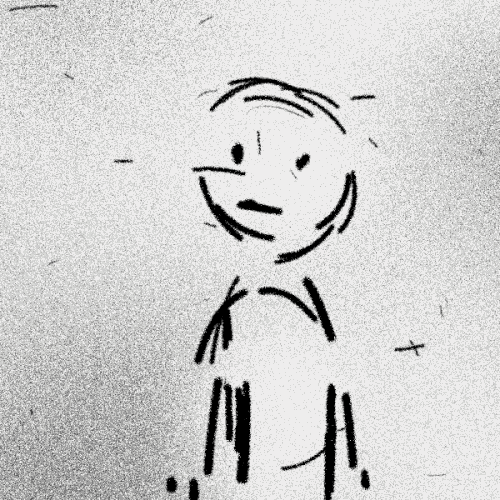
At many points in my life, I have undergone a complete loss of reason and meaning in the everyday, and witnessed things that once seemed so complete and normal in form, vanish into nothing but anamorphic objects. I wanted my listener to realise how superfluous and gratuitous their existence can seem, but to also realise that there is so much freedom in their own interpretation of the universe around them. We are all ‘set free to find a new illusion,’ as Lou Reed puts it in I’m Set Free (quite a philosophical number by The Velvet Underground that you have to check out if you haven’t).
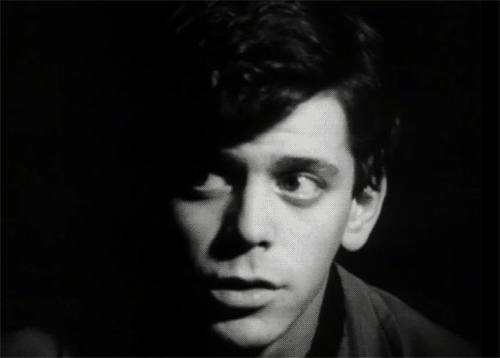
So in this piece, I attempted to encapsulate the Cartesian atmosphere, the intricate prose, the anxious voice and some of the compelling ideas and transform them into something musical. I used a standard song form with verses and choruses, but challenged myself by using electronic instruments. This process was different from my regular, as I usually write more for the folk and rock genre. For easy referencing and to be specific, I chose a particular passage from the book to write the lyrics and achieve the vibe.
INTRO
I began composing this piece on an old blue piano that I found in the share house I just moved into. The piano’s subtle complexities put me in a trance and allowed me to freely improvise a few different chord progressions. I didn’t even start with a key or by using any musical theory methods; I just played what I felt was right at the time. In retrospect, I was using dissonance at the core of my ideas, by playing a C major chord on a lower register and a B minor chord on the octave above. This gave the song a distinctive Lydian sound (a mode I’ve always been drawn to for a subconscious reason unknown to me). After I found the idea, I moved it to Logic Pro X and put the progression in using my midi keyboard.
I then edited the sound using the EXS24 setting; I did this by tweaking the envelope, cutoff, resonance and the first LFO to achieve a compelling synth sound.
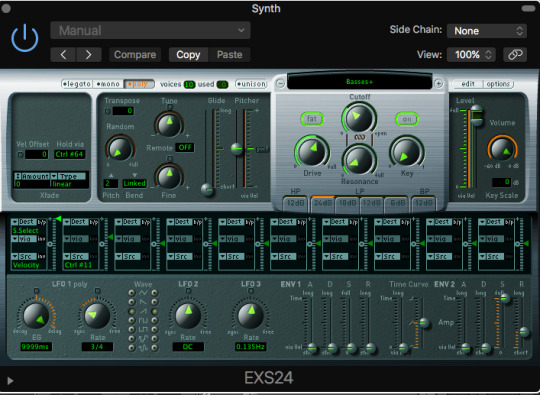
Now that I had a rhythm part for my intro, I needed a catchy main riff that would repeat throughout the song and serve as a link between sections … something odd, pensive and slightly dissonant to represent the chaotic nature of existentialism and nihilism. I began with a piano sound and wrote the melody over the chords. At that moment I had been listening to a lot of repetitive music that had the same chord progressions occur over and over again; but captivated their listeners eardrums by using unusual third dimensional tone colours and Layer Cake Orchestration. Some of these tunes included I Am The Changer By Cotton Jones or The Magician by Andy Shauf; where the listener is pulled in not by the repetition itself, but by the trance inside the repetition. This evolves from a distant ambience that reflects the blackness of space …
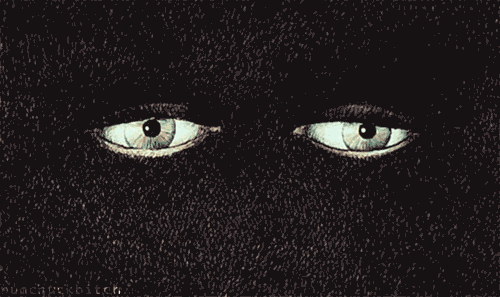
I made the melody slightly repetitive, but used a variety of colours and instruments to make it interesting. I accomplished this by importing the previous piano sound from my cataplexy assignment (as I was satisfied with how that had turned out), and then layered it with a mellotron boy’s choir and cello to form a ‘super-instrument.’ I modified all of these by once again altering the envelope, EQ and LFO settings. I added a drone with a synth, samples of the wind (which I automated the pitch of) and a record player to create more complexity within the space. It would have been preferable to have a string section with a lot of staccato moments, but unfortunately I did not have the time or the players. If I were to work on this some more, this would be an option.
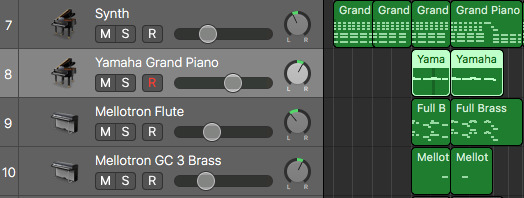
Now it was missing two core ingredients, bass and drums. I started building the drums using the Liverpool drum kit on Logic and then took to the keyboard to write the part. When I listened to Andy Shauf’s Magician, I really liked the simplicity of the four-to-floor beat. It showed me how much attention a beat can give to a melody. So I made my beat very simple and added an 808 snare to the snare hits, for some extra lustre. I EQ’d the drums and compressed them, until they were up to my standard …

With the bass, I simply followed the bass drum hits, so they were glued to the beat. In regards to tone, I chose a bass from the string category in Logic and altered its EQ by putting on a low pass filter. After being told by my teacher to reduce the bass frequencies and make them clash less, I also brought down the volume and the low frequencies by one decibel.
The rhythm synth that plays the chords in the lead up to the main riff needed a strong crescendo to accompany it (so it could build tension for the moment it came in). To do this I added some strings and played around with the EQ to make them sound less like midi strings. Then I increased the attack on the envelope, so the sound would automatically build. I doubled these tracks and panned them to both sides. As they grew in volume, I automated the panning on both sides to come into the centre.
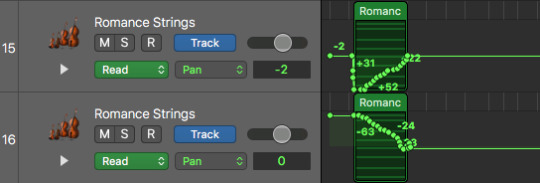
VERSE 1, 2 & 3
Next I had to think about the vocal melody for the verse chords, so I played through the chord progression and improvised some melodies until I found something that worked. The lyrics spawned relatively easy out of this. I went through the passage and used words and phrases that caught my attention and based the lyrics around these. Some lines that shaped the song were...
“I got up and went out of the park. Once at the gate, I turned around. Then the garden smiled at me. I leaned against and watched for a long time. The smile of the trees, the clump of laurel meant something: that was the real secret of existence.”
“Time had stopped: a small black pool at my feet; it was impossible for something to come after this moment.”
“Everything is gratuitous, this park, this city, and myself. When you realise this, your heart turns over and everything begins to float....”
and this biggy ...
“Had I dreamed this enormous presence? It was there, deposited on the garden, tumbling down in the trees, all soft, sticky, soiling everything, all thick, a jelly. And I, was I inside, with the garden? I was frightened, furious, I thought it was so stupid, so out of place. I hated this ignoble messiness. Piling up to the sky, spilling over, filling everything with its gelatinous slither, and I could see depths upon depths of it reaching far beyond the limits of the garden, the houses, and Bouville, as far as the eye could reach. I was no longer in Bouville; I was nowhere, I was floating. I was not surprised, I knew it was the World, the naked World revealing itself all at once, and I choked with rage at this gross absurd being. You couldn't even ask where all this came from, or how it was that a world existed, rather than nothingness. It didn't have any meaning, the world was present everywhere, before, behind. There had been nothing before it. Nothing. There had never been a moment in which it could not have existed. That was what bothered me; of course there was no reason for its existing, this flowing larva. But it was not possible for it not to exist. It was unthinkable: to imagine nothingness you had to be there already, in the midst of the World, eyes wide open and alive; nothingness was only an idea in my head, an existing idea floating in this immensity; this nothingness had not come before existence, it was an existence like any other and appeared after many others. I shouted, What filth, what filth! And I shook myself to get rid of this sticky filth, but it held and there was so much, tons and tons of existence, endless. I suffocated at the bottom of this immense weariness. And then, all at once, the park emptied as through a great hole. The world disappeared as it had come, or else I woke up — anyway I saw no more of it; nothing was left but the yellow earth around me, out of which dead branches rose upward.”
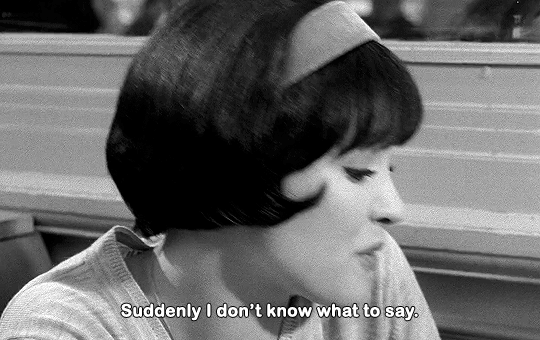
Throughout the semester, I have been experimenting a lot with my vocals by using doubling, panning and auto tune. So I recorded a vocal track, doubled it, panned one to the left and one to the right and auto-tuned the one on the left, so that there would be a tension between the auto-tuned and the natural track. Then I added harmonies where I felt the melody needed it and doubled and panned these as well. The auto tune I used is displayed below …
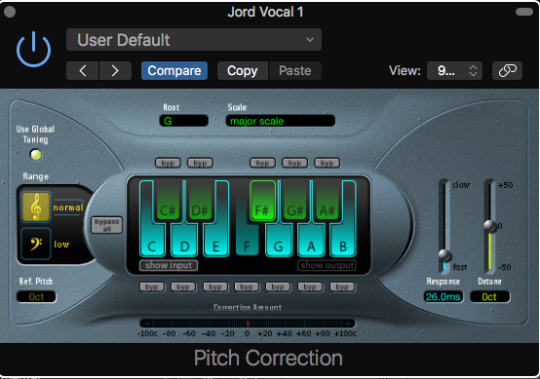
I used a moderate amount of compression and EQ on all the vocals, which can be seen on my plug-in strip. I also bussed all the vocals to an auxiliary channel with EQ and compression so they sounded more together
Here are my plug-ins along with the Eq and compression settings...

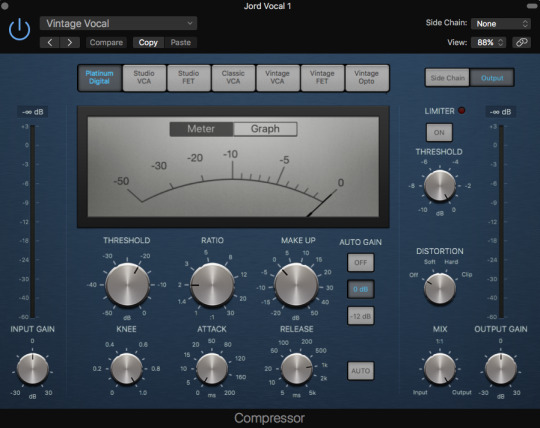

Throughout the three verses, I introduced a mellotron string and flute part to avoid repetition and made it call and respond to the vocals from the second verse. For this section, I looked to Bowie’s Quicksand, using Mick Ronson’s wreathing string parts as inspiration. I love how the ascending runs can really send the song into another dimension. I then put more harmonies in as the part progressed. After this, the song grows into the chorus…
Chorus 1
I needed a key change for the chorus, so I went back to my piano sound and dropped the key down a tone (Stevie Wonder style). ‘All of this filth,’ derived from one of the lines I had read in the passage. Once I had the vocal melody down I needed a countermelody, so I designed one on the mellotron string and flute part. I also introduced a new synth and automated the cut-off (using retro synth on Logic), so the sound would grow in the vocal breaks, acting as an antiphony to the vocals.
With the drums, I changed the high hats to the ride cymbal to create more space. I added fills where apt and a conga loop from Logic’s library for more oomph. In the build up to the link, the piece changes key again and after the lines ... ‘the moments we have,’ I paired a reverse gong with the original string rising part to build it more. I also automated the pitch of the gong, so it rose with the strings. With the vocals I had to automate the key of the pitch shifter in order to align the vocals to the right key.
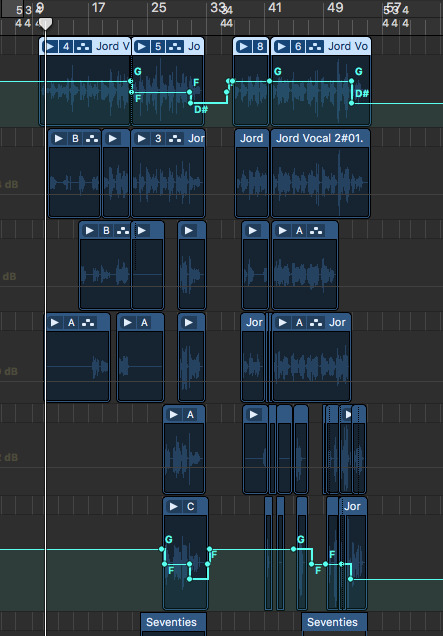
Link 1
For the link (the main riff), I needed it to be slightly different to when the melody first appeared at the beginning. So I added some mellotron brass, playing intervals in a drone-like way and once again modified the sound. I also made it half the length, so it would flow better into the second verse.
Verse 4 & 5
To create variety in these sections, I wrote new lyrics and I added some harmonies to the call and responses on the strings. I also added an ultrabeat sample from logic, to enrich the beat and a new high hat rhythm doing quavers to fasten the pace. Here is a picture of the ultrabeat synth I used.
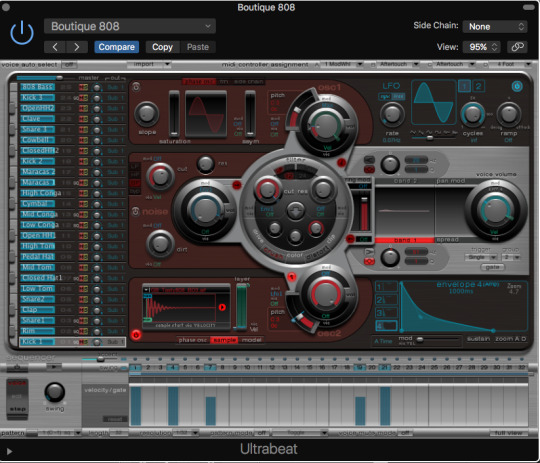
Chorus 2
For the second chorus I wanted more layers and climax, so I harmonised the vocals and made the mellotron parts more ... well ... climactic. I accomplished this by making the melodies higher and building triads out of them in the second half. I automated the volume on the build at the end to make it sound bigger than the first too.
Link 3
This is the same length as the first main riff. But is bigger in sound, because of the layering …
Instrumental
The instrumental is the same as the chorus without vocals, and has the same mellotron part. I chose to use the same part, as I wanted the attention on the mellotron part this time, instead of the vocal. The only difference was that I automated the mellotron’s EQ, bringing out higher frequencies and lower frequencies to contribute to the psychedelic feel.
Outro
The song ends with the main riff playing twice. Except the second time the layers strip back revealing the sound of the riff without drums, which I thought was an effective contrast.
Here is my piece with all the tracks and automation shown ... I mixed the levels as I went to get a consistent mix and mastered in a separate project (adjusting the levels with EQ, compression to get it tighter and a limiter and an exciter for more colour).
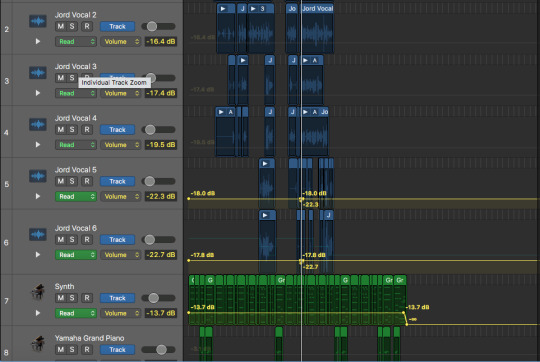
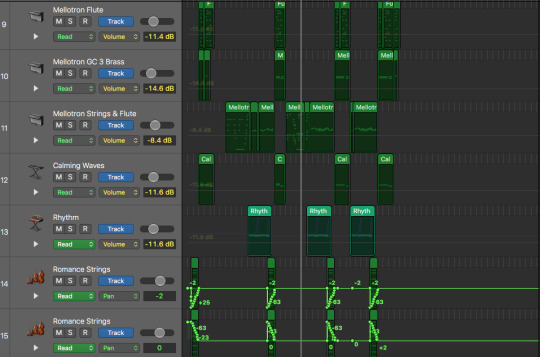
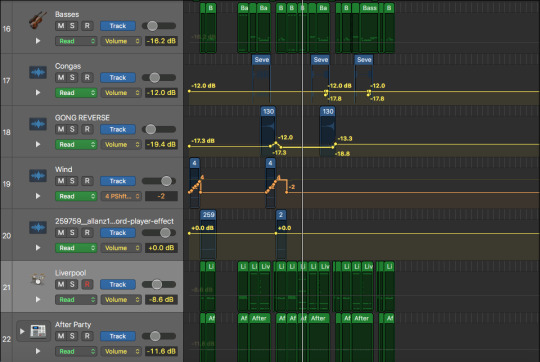
My mastering channel strip...

Overall I was happy with how my piece turned out, although I would love to see it done with a real kit and string section, as I think this would definitely make it more impactful. I hope this piece challenges people to find meaning within nothing ... and on that note ...
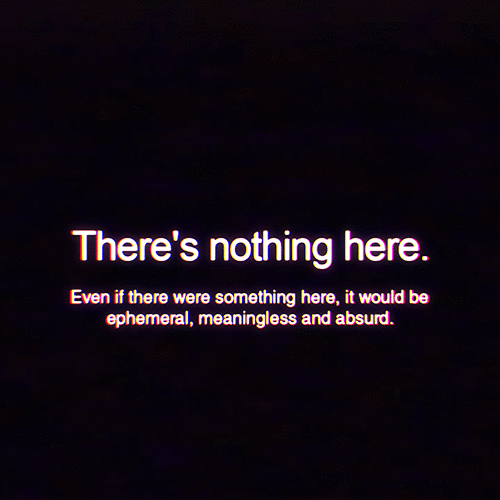
By John Korosi aka Jordan Kenny
0 notes
Text
Why Every Musician Should Care About Jazz Theory
Hey guys!
So, today’s post is going to be very much different from the first one. I’ll be jumping around with my topics to try and keep my audience engaged. You will realize that I will be talking about jazz a lot in my blog. As a jazz vocalist, I feel like jazz is the area where I could help those reading the most. Now, just because I’ll be talking about jazz doesn’t mean that this blog is only aimed at jazz majors or jazz musicians, anybody is welcome to read and take away what you will from my posts, and I’ll actually aim some of my posts more so towards classical musicians to help them learn a bit more about jazz.
My post today, specifically, will talk about jazz theory. I’ll talk a bit about what jazz theory is and how it differs from classical theory. Every musician at one point or another, are going to run into elements of jazz in their musical studies, and while they may seem intimidating at first, this post will talk about why there’s nothing to fear, and jazz theory is actually pretty fun!
I’d say the first thing there is to talk about is swing. Swing is the most common rhythm found in most genres of jazz. It differs from straight rhythm in that it has a more laid back feel, and it feels almost as if the beat is behind. The note most commonly swung is the eighth note, and while there’s ways of swinging quarter notes or sixteenth notes, we’ll focus on the basic swing feel for now.

A straight eighth note rhythm pattern reads as “1+2+3+4+”. On the other hand, to get the feel of a swing eighth note pattern, think eight note triplets.

From here, tie the first two notes together.

That’s pretty much all there is to it, really! That’s how one reads swing eighth notes. This kind of rhythm can be found pretty much in any genre of music, ranging from broadway to orchestra pieces, and it can be confusing the first time you stumble upon it. Hopefully, this can give you a better understanding on how swing eighth notes work.
Next thing I’d like to talk about is extended harmonies. Jazz uses extended harmonies such as major sevenths, ninths, elevenths and thirteenths. The purpose is to give the music different colors, as well as dissonance which is then resolved with resonance. For instance, on top of a C major triad, C-E-G, you would add maybe a B to make it a Cmaj7 chord, or make the B flat to make it a C7, or C dominant 7th. Even above that, you can add a ninth, which is really the second (D), a sharp or flat eleventh (F) or a flat thirteenth (A), depending on the color you’re looking for. You learn to make these harmonic choices with time, and it really comes down to what you’re looking for in accordance to your melody. While this may seem complicated and a far reach from anything related to classical music, it’s really not a stretch when it comes to composers such as Poulenc, Gershwin, and Debussy. Having a general understanding of these harmonies can help you hear them in your music, and understand why they were put there by the composer.
In another post another week, I’ll get a bit into jazz modes and scales and how they work with the extended harmonies we talked about today. Meanwhile, I’d love to hear some feedback from you guys, so let me know what I could work on for next week and I’ll make sure to take it into consideration. I covered a lot of ground today, so please let me know if I’m going too fast, or if there’s something that you did not understand that I could help explain. Thank you so much for reading!
0 notes
Photo
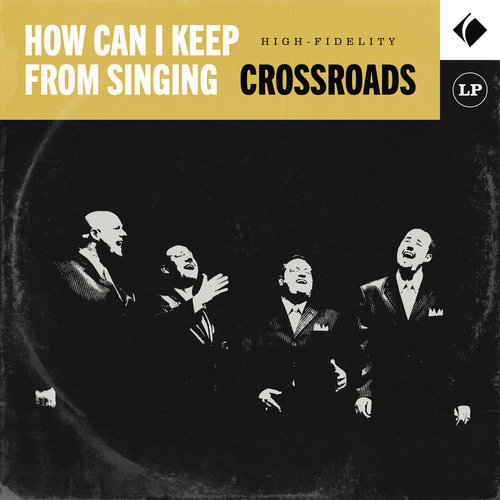
HOW CAN I KEEP FROM SINGING by Crossroads
A review by Todd Wilson
So I got a text on July 20th from my friend Fred Farrell. The point of his contact was to ask if I would consider publishing a review of Crossroads' fourth CD release, How Can I Keep from Singing.
Before Fred, Jim, Brandon and Mike came together from other notable champion quartets to form Crossroads, and quickly won the International Quartet Championship in 2009. I have appreciated their friendship and admired their individual musicianship. As I pondered Fred's request for a hot minute, the first word that came to my mind was "Wow!" Like my own championship foursome ACOUSTIX, Crossroads sings a wide variety of musical styles including vocal jazz, blues, gospel, pop classics, and classic American standards. While I have served as a judge at a number of singing events, and for the Contemporary A Cappella Recording Awards over a span of almost 20 years, I have never been asked to review a new CD, so I am looking forward to this new journey in my music-filled life. LISTENING ENVIRONMENTS: I listened to these tracks in my car, on my Bose Sound Dock, and using my Fostex T20RP studio headphones. I enjoyed this recording the best in my car, as I could get more gain. My next favorite was the headphones as I could diminish background noise. The Bose speakers were last, but are portable and convenient. DISCLAIMER: Reviews are so very subjective. What I will share are my candid, personal opinions. I do not expect everyone to agree with my assessment.
01 - Just One of Those Things This refreshing new Aaron Dale arrangement opens with a scat solo by bass singer Dr. Jim Henry, and includes a wide variety of musical elements to keep things interesting. While I have no critique of the singing, Crossroads never disappoints in that category - the dynamic range felt a bit too compressed. The mix throughout this project does seem a bit dry for my personal taste but does allow Crossroads to better replicate what you might hear in an an up close and personal live performance in someone's living room at an after, afterglow. The tag was a nice musical surprise, but did not have the climactic feel you might expect. Regardless, this track showcases the amazing skills of these four singers quite well. 02 - Butter Outta Cream I've never heard this composition before and am grateful to Crossroads for expanding my horizons with this one. Great storytelling exhibited with this performance throughout. The melodic line of this song is not easy, but Mike Slamka makes difficult passages sound so effortless. Jim's solo was equally masterful and expressive, but I'd love to hear him showcased a bit more by diminishing the gain of the BGVs a wee bit and adding a touch more verb. The dry mix worked better for me on this track, than the first, however, the compressed dynamic range still left me wanting more of what we might experience from a live performance. And YES, these guys do look like they enjoy butter and cream. : ) 03 - This Heart of Mine This song grabbed me from the first word and held my attention to the very end. That statement defines emotional engagement. On the first two tracks, my ears were drawn more to (lead and bass) Mike and Jim. Fred and Brandon did nothing to call attention to what they were doing or distract me in any way. This ballad was a great vehicle to demonstrate the mood you can create when four gifted voices come together to tell a powerful story. But, it really showcased the vocal prowess of Brandon on baritone and Freddie on tenor. All four singers OWNED this performance. Hearing this made me want to reach out to arranger Brent Graham to request the sheet music so I could perform this song with my brothers in the Nashville Singers. My favorite track so far. Well done gents. 04 - A Wonderful Time Up There Intros can be a chance to capture the attention of the listener, get you in the right mood, and set the tone for the rest of the song. That said, I could have done without the first 10 seconds of this track. With the Blackwood Brothers, this southern Gospel classic showcased their bass singer, J.D. Sumner. David Wright's arrangement, while dominated by the dulcet tones of bass singer Dr. Jim Henry, also included solos by lead singer Mike Slamka and baritone Brandon Guyton. When it comes to nailing the soulfulness you often hear in great gospel quartet soloist, Brandon Guyton won the authenticity award in this mini version of the "Sing-Off." Jim's mastery of his voice through a huge range is very impressive. The over use of the off beat "dots" from the BGVs got a bit tedious for my taste. In a coaching session, I would encourage an alternative of some kind.
05 - St. Louis Blues A song/arrangement like this was meant for Crossroads. Mike has such a soulful, expressive interpretation of this W.C. Handy masterpiece, arranged by David Wright. The rest of his quartet mates add the icing to the cake. They have fun with the dissonance and occasional bending of the pitch to blues it up a bit, but not too much. Jim drops a low C a few times and I could almost envision him winking as he does it. The guys exhibit a tasteful and appropriate contrast in dynamics. 06 - The Devil Ain't Lazy This chart opens with Dr. Jim and again, he does not disappoint. All four singers generate a great deal of vocal excitement, executing close jazzy chords and tricky rhythms like pros. These guys are consummate storytellers. 07 - Not Like This Wow. Just wow. OK, that's not much of a review. Let me elaborate. Take Crossroads, add the the international mixed quartet champion, Double Date, throw in a killer arrangement by Dr. Jim Henry and a soulful solo by Brandon Guyton and what you get with this track is both magical and beautiful at the same time. I have listened to this track over and over again and do not tire of it. No critique necessary. It's marvelous, and worth the price of the CD on its own. 08 - Get On Board I think you'll enjoy this catchy, uptempo toe-tapper originally popularized by The Isaacs, and arranged by Mike's son-in-law Nathan Johnson. I loved the key changes and solos. 09 - They Could Not I really like this Steve Armstrong arrangement, Mike's treatment on the melody and of course the message. These guys came together to present a majestic performance of this Sandi Patty song written by Ron Harris and Claire Cloninger. 10 - Hello Young Lovers Rodgers and Hammerstein collaborated on this composition for "The King and I." Arranged by David Wright, this is a huge departure from the original interpretation. Kudos to David for his creativity and vision and to the guys in Crossroads for bringing it to life. I really enjoyed this jazzy uptempo treatment, the wacky chords, and Dr. Jim's walking bass lines. 11 - How Can I Keep From Singing The lush, fat, and warm chords in the intro set the tone for this gorgeous hymn quite nicely. This David Wright arrangement showcases the sweet, tenderness in Mike's lead voice. He makes it sound so effortless. Jim Henry has many solo sections on this project, but his delivery on this song is my favorite of the bunch. That said, from a mixing point of view, I would have pulled the fader bar down a bit on the BGVs to let Jim's warmth and resonance wrap around me (the listener) even more. The tenderness, dynamics and reverence complemented the message perfectly. Bravo guys!
youtube
12 - You're My Best Friend The final cut on this project has Crossroads performing a Queen song arranged by Aaron Dale, includes Vocal Spectrum, solos by Mike Slamka and Tim Waurick, and vocal percussion by Nick Gerard. As with track 7, when you bring that much talent to the table, expectations are going to be huge. Were they met? Almost. But when your expectations are that lofty, "almost" is still very, very impressive. The singing by both quartets (as expected) was superb. The VP wasn't as distracting as I thought it might be. The arrangement kept things interesting, captured the essence of the original Queen score and introduced some new elements to boot. When you record a rock classic like this, comparisons to the original are unavoidable. The solos were stellar, but none of them delivered the sometimes "over the top" edge and passion delivered by the late Freddie Mercury. But then again, not many singers are born with those kinds of pipes? Still, this track left me wanting more. Pardon the minutia again, but similar to one of my observations in track 4, I was a bit distracted by the repeated "dah" on the tonic C note. I probably would have modified this to a "doo" and/or lower the gain a wee bit on that particular element. I liked the sweet and tender treatment at the beginning, but as the arrangement unfolded, I was hoping to hear some more edgy expressiveness to complement what was happening in the arrangement. Speaking of comparisons, when you include a contemporary a cappella chart in your project, my musical brain could not help but wonder what a few of the best collegiate a cappella groups, like the Tufts Beelzebubs or On the Rocks might have done with this chart? To end this review on a night note, (excuse the pun) another thing this track has going for it is a four-octave spread on the last chord. Nice!
In closing, this is a very fine, quality recording project with something for everyone. I encourage you to order your CD or digital download today. It's been nine years since Crossroads won the International Quartet Championship of the Barbershop Harmony Society and these four guys continue to raise the bar musically. It's an honor to have them as my friends and brothers in the Association of International Champions. They have been and will continue to be outstanding ambassadors for the a cappella community. It is no surprise that Crossroads was awarded "Quartet of the Year" in May 2018 by the inaugural A Cappella Music Awards program.
Order a copy of this or other CDs by Crossroads by clicking this link https://www.crossroadsquartet.com/cds/
0 notes